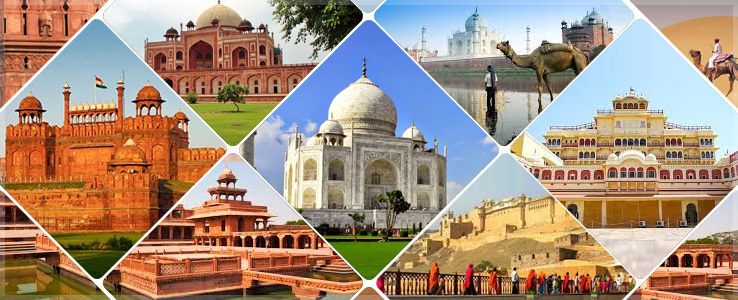Understanding the Golden Triangle Circuit
The Golden Triangle of India connects three of the country's most iconic cities—Delhi, Agra, and Jaipur. This triangular travel route is renowned for its cultural diversity, architectural brilliance, and deep historical relevance. The name “Golden Triangle” comes from the triangular shape formed when these cities are plotted on a map. Each leg of the journey offers a distinct glimpse into India’s layered past, rich traditions, and vibrant present.
Delhi, the capital, is a dynamic blend of Mughal architecture, colonial legacies, and modern infrastructure. Agra, once the seat of the mighty Mughal Empire, is home to world-famous monuments. Jaipur, the Pink City, showcases the glory of Rajputana architecture and royal traditions. Together, they form a cohesive journey through northern India’s soul.
Delhi: A Living Museum of History
Delhi stands as a testament to more than a thousand years of political and cultural evolution. From the towering Qutub Minar to the bustling lanes of Chandni Chowk, the city encapsulates multiple dynasties and influences. Visitors often start their tour at India Gate, then explore landmarks such as Humayun’s Tomb and the Red Fort.
Modern Delhi, with its well-connected Metro, world-class museums, and diverse culinary offerings, provides a smooth introduction to the Indian way of life. Beyond just sightseeing, Delhi invites you to experience layered urban storytelling—through street art, Sufi music performances, and age-old street food stalls.
Agra: The Legacy of Love and Empire
A mere 230 km south of Delhi, Agra is one of the most significant stops on the Golden Triangle route. Known globally for the Taj Mahal, this city was a flourishing center under the Mughal Empire. The white marble mausoleum, built by Shah Jahan for his wife Mumtaz Mahal, is not just a symbol of love but a marvel of engineering and design.
However, Agra’s significance goes beyond the Taj Mahal. The Agra Fort, a UNESCO World Heritage Site, tells stories of emperors and their reign. Nearby, the tomb of Itimad-ud-Daulah—often called the “Baby Taj”—offers a preview of the design brilliance seen in the Taj Mahal.
For those interested in architectural evolution and imperial history, the Same Day Guided Tajmahal Tour with Agra Fort and Baby Taj offers in-depth insights without the need for overnight travel.
Jaipur: Royal Grandeur and Cultural Flourish
Completing the Golden Triangle, Jaipur immerses visitors in the regal charm of Rajasthan. The city’s planned layout, painted facades, and majestic forts stand in contrast to the urban chaos of Delhi and Agra. Built in 1727 by Maharaja Sawai Jai Singh II, Jaipur combines scientific urban planning with traditional aesthetics.
Landmarks like the Hawa Mahal, City Palace, and Jantar Mantar reflect royal vision and scientific curiosity. Amber Fort, with its hilltop view and elephant rides, adds a medieval flavor to the journey. Equally engaging are Jaipur’s local bazaars that sell handcrafted jewelry, textiles, and block-printed fabrics.
For wildlife enthusiasts looking to expand their cultural tour, the Ranthambore Gypsy/Jeep Safari from Jaipur offers a thrilling extension into the wild terrains of Ranthambore National Park.
The Cultural Core of North India
What binds Delhi, Agra, and Jaipur together is their representation of different yet interconnected cultural paradigms. Delhi provides the backdrop of Islamic and colonial influences; Agra captures the essence of Mughal grandeur; and Jaipur celebrates the legacy of Rajputana heritage.
Every destination in the Golden Triangle is a living museum. From street performances and artisan communities to temple rituals and local cuisines, the region offers an immersive experience of India’s cultural ethos. A golden triangle india tour package doesn’t just cover monuments—it helps contextualize the country's multifaceted identity.
Best Time to Experience the Golden Triangle
The ideal time to explore the Golden Triangle is from October to March. These months offer pleasant weather for sightseeing, camel fairs, and festivals like Diwali and Holi. Travelers also benefit from better visibility and accessibility to both historical and natural attractions during this period.
Avoiding the summer heat (April–June) and the heavy monsoons (July–September) ensures a more comfortable travel experience. However, off-season travel may appeal to those who prefer fewer crowds and lower travel costs.
Customizing Your Golden Triangle Journey
While the basic route covers Delhi, Agra, and Jaipur, many travelers enrich their itinerary with additional destinations. Udaipur, Jodhpur, and Pushkar are popular extensions for those interested in exploring more of Rajasthan’s art, temples, and rural life.
By opting for curated Rajasthan Tour Packages, travelers can integrate visits to iconic forts, desert camps, folk music performances, and even spiritual retreats. Each stop enhances the thematic depth of the Golden Triangle and offers a well-rounded experience of India’s cultural geography.
Conclusion: A Gateway to India’s Soul
The Golden Triangle Tour is more than a sightseeing trip—it's a narrative journey through time, aesthetics, and living traditions. It provides a structured yet flexible framework to understand the political, spiritual, and artistic developments that shaped India.
Whether you are drawn by the symmetry of Mughal gardens, the intricacies of Rajput palaces, or the colors of daily life in Indian bazaars, this route delivers an authentic and enriching travel experience. By approaching the Golden Triangle with curiosity and respect, travelers gain not just memories, but meaningful insights into one of the world’s oldest civilizations.
